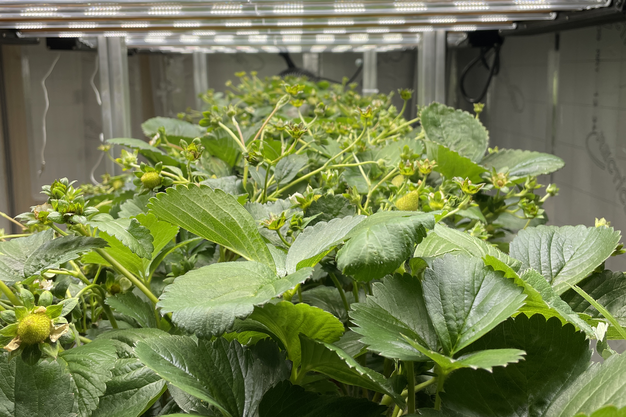"I found that people didn't know much about both hydroponics and strawberries. There's a gap in training for early career researchers and technicians, and it's a steep curve to get someone on board for the industry," says Katia Zacharaki, founder of Innophyte Consulting and an avid strawberry specialist. Recently launched, Katia and her team at Innophyte Consulting aim to address the industry's pressing need for senior R&D and science through a comprehensive set of "Science as a Service" offerings.
Innophyte Consulting supplies expertise in growth recipes, market analysis, data analysis, and visualization, and supports experimental data collection as well as investor deck preparation. "We provide insights from a scientific point of view, with a strong emphasis on grant writing and project management."

Katia Zachariki
Science as a Service
Katia's new business venture addresses the industry's challenges which she and her colleagues have noted through experience of R&D projects and research. She aims to provide 'Science-as-a-Service' solutions that integrate plant science, marketing, and strategic planning. Katia is joined by Dr Jim Stevens, a seasoned researcher with a diverse background, from plant science to banking and journalism. Jim specializes in sensor technology, data analysis & modeling and grant writing. Katia's new venture has been approved as a Monitoring Service Provider for Innovate UK, supporting successful grant-funded projects throughout their journey.
How it all started
Katia's journey began in Greece, where she obtained a master's degree in agricultural engineering and agronomy, followed by an MBA in agribusiness at the Agricultural University of Athens. Despite having graduated third in her class, Katia was overqualified in Greece, and alongside the financial crisis, she decided to move to the UK. However, this did not deter her.
Once in the UK, she began a fully-funded PhD as well as lecturing at a local agricultural college. Shortly after starting, she was offered a new role in a vibrant vertical farming startup in Wales and moved her PhD to Harper Adams University. The focus of her work now pivoted to strawberries in vertical farming settings. Her involvement in vertical farming deepened as she collaborated with partners and industry experts. In 2020 she also joined UKUAT on a pro bono basis, as Director of Communications, aiming to support the industry and spread the work of urban farming.

Lowering the entry bar for strawberry cultivation
Katia has often seen strawberry Total Controlled Environment Agriculture (TCEA) businesses fail, but she thinks that there are mistakes that are preventable and easily fixed. "I've seen the hurdles that growers face with strawberry cultivation in a controlled environment. Plant physiology, management of plant pathogens, choice of propagation material, fertigation, pollination, and environmental requirements are the most common challenges," she explains. Her extensive experience with strawberries in both traditional and vertical farming settings gives her a refreshing perspective on overcoming these obstacles.
"In biology, it's often so different to what's promised on paper. You start with a cultivar, collect data, and repeat your trials. Otherwise, in the absence of public research, it's challenging to know what works and what doesn't," she adds.
Breaking the code
Despite the complexities, Katia believes that the industry is on the verge of breakthroughs. "Some have cracked the code for strawberry farming, but it's not just about the growing element. It's about tying everything together: marketing, strategy, and a holistic understanding of plant physiology," she says.
Katia's approach involves detailed experimental design, data collection, and visualization. "I can support decision-making, set up consistent lighting, explain how plants grow, and suggest solutions to technical challenges. Through my experience, I assess the entire envelope, from growth environments and nutrient solutions to cultivar selection all of which are critical for successful strawberry cultivation."

How viable are CEA setups for strawberries?
When asked about the most ideal setup for a strawberry farm, Katia offered a critical view. "Financially, it makes more sense to go for volume in CEA setups which means glass or polytunnels. For niche markets with high selling prices, smaller volumes in TCEA, such as vertical farms, are viable. While TCEAs provide the best physiological conditions for plants, there are risks when scaling up."
Pointing out practical considerations that are often overlooked in vertical farm designs, Katia highlights "Transpiration rates, microclimate management, and plant accessibility are critical factors. The vertical farming industry is used to working with shorter-cycle plants, like leafy greens and microgreens whose management is significantly less challenging than strawberries. These problems multiply as farms get larger.
For instance, HVAC requirements for strawberries vary throughout their long life cycle. They require humidification during the vegetative stage to reduce VPD yet from flowering onwards require dehumidification. The dehumidification requirement peaks about 3 months into the cultivation cycle, due to the size of the plant canopy. This is when we see most issues with pollination and fungal infections. An attempt to spec HVAC based on average requirements would thus result in significant crop losses. All these could be avoided with the right insights." she warns.
"Apart from strawberries in TCEA, there is so much more that the AgriTech sector can contribute to a more sustainable future. By making science more accessible to SMEs we can contribute one little piece at a time. As long as we provide value, our clients will benefit," she concludes.
 For more information:
For more information:
Innophyte Consulting
Katia Zacharaki, Founder and head researcher
katia@innophyte.co.uk
https://innophyte.co.uk
